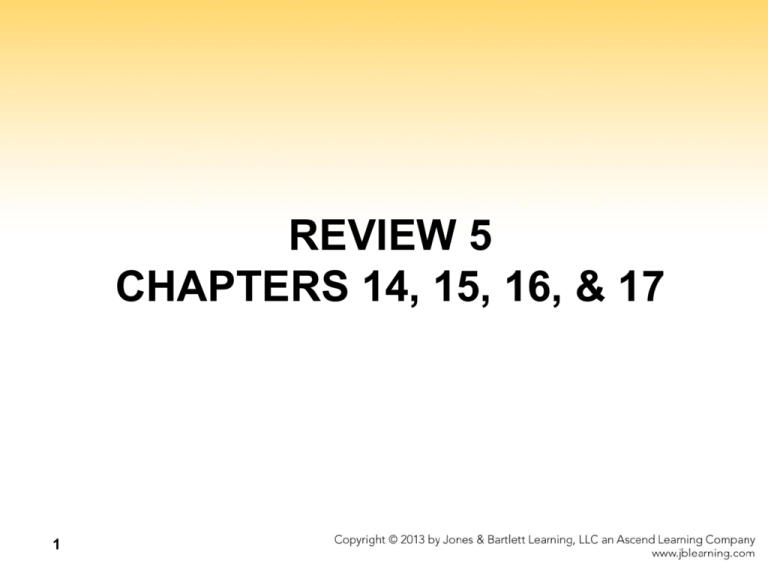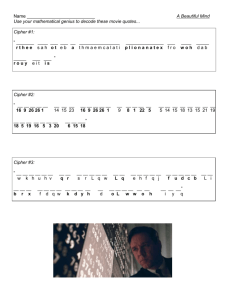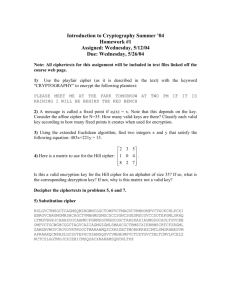Review #5
advertisement

REVIEW 5 CHAPTERS 14, 15, 16, & 17 1 CHAPTER 14 2 What Is Simulation? Simulation A model of a complex system and the experimental manipulation of the model to observe the results Systems that are best suited to being simulated are dynamic, interactive, and complicated Model An abstraction of a real system It is a representation of the objects within the system and the rules that govern the interactions of the objects 3 Constructing Models Continuous simulation – Treats time as continuous – Expresses changes in terms of a set of differential equations that reflect the relationships among the set of characteristics – Meteorological models fall into this category 4 Constructing Models Discrete event simulation Made up of entities, attributes, and events – Entity The representation of some object in the real system that must be explicitly defined – Attribute Some characteristic of a particular entity – Event An interaction between entities 5 Queuing Systems Queuing system A discrete-event model that uses random numbers to represent the arrival and duration of events The system is made up of – servers – queues of objects to be served 6 Graphics Graphics Originally the language of communications for engineers, designers, and architects Computer-aided design (CAD) A system that uses computers with advanced graphics hardware and software to create precision drawings or technical illustrations 7 Graphics Illumination model Simulation of light interaction at one point on an object Shading model (shading) Process of using an illumination model to determine the appearance of an entire object Rendering The process of creating an entire image 8 CHAPTER 15 9 Networking Computer network A collection of computing devices connected in order to communicate and share resources Connections between computing devices can be physical using wires or cables or wireless using radio waves or infrared signals 10 Networking Node (host) Any device on a network Data transfer rate (bandwidth) The speed with which data is moved from one place to another on a network 11 Networking Computer networks have opened up an entire frontier in the world of computing called the client/server model Figure 15.1 Client/Server interaction 12 Networking Protocol A set of rules that defines how data is formatted and processed on a network; i.e., rules that allow client/server interaction File server A computer that stores and manages files for multiple users on a network Web server A computer dedicated to responding to requests (from the browser client) for web pages 13 Types of Networks Local-area network (LAN) A network that connects a relatively small number of machines in a relatively close geographical area Ring topology connects all nodes in a closed loop on which messages travel in one direction Star topology centers around one node to which all others are connected and through which all messages are sent Bus topology nodes are connected to a single communication line that carries messages in both directions 14 Types of Networks Ethernet Figure 15.2 Various network topologies The industry standard bus technology for local-area networks Types of Networks Wide-area network (WAN) A network that connects local-area networks over a potentially large geographic distance Metropolitan-area network (MAN) The communication infrastructures that have been developed in and around large cities Gateway One particular set up to handle all communication going between that LAN and other networks 16 Packet Switching Packet A unit of data sent across a network Router A network device that directs a packet between networks toward its final destination Packet switching Messages are divided into fixed-sized, numbered packets; packets are individually routed to their destination, then reassembled Packet Switching Figure 15.4 Messages sent by packet switching Take a message, break it into three packets, and simulate this process 18 Network Protocols Network protocols are layered such that each one relies on the protocols that underlie it Sometimes referred to as a protocol stack Figure 15.6 Layering of key network protocols 19 TCP/IP Transmission Control Protocol (TCP) Software that breaks messages into packets, hands them off to the IP software for delivery, and then orders and reassembles the packets at their destination Internet Protocol (IP) Software that deals with the routing of packets through the maze of interconnected networks to their final destination 20 High-Level Protocols Other protocols build on TCP/IP protocol suite Simple Mail Transfer Protocol (SMTP) used to specify transfer of electronic mail File Transfer Protocol (FTP) allows a user to transfer files to and from another computer Telnet used to log onto one computer from another Hyper Text Transfer Protocol (http) allows exchange of Web documents 21 Firewalls Firewall A gateway machine and its software that protects a network by filtering the traffic it allows Access control policy A set of rules established by an organization that specifies what types of network communication are permitted and denied 22 Network Addresses Hostname A name made up of words separated by dots that uniquely identifies a computer on the Internet IP address An address made up of four one-byte numeric values separated by dots that uniquely identifies a computer on the Internet 23 Network Addresses Figure 15.9 An IP address is stored in four bytes 24 Domain Name System Domain name system (DNS) A distributed system for managing hostname resolution Domain name server A computer that attempts to translate a hostname into an IP address 25 Domain Name System Host number The part of the IP address that specifies a particular host (machine) on the network Yes, but what is it? Domain name The part of a hostname that specifies a specific organization or group Top-level domain (TLD) The last section of a domain name that specifies the type of organization or its country of origin 26 CHAPTER 16 27 The World Wide Web The Web An infrastructure of information combined and the network software used to access it Web page A document that contains or references various kinds of data Links A connection between one web page and another 28 The World Wide Web Website A collection of related web pages Web browser A software tool that retrieves and displays eb pages Web server A computer set up to respond to requests for web pages 29 The World Wide Web Uniform Resource Locator (URL) A standard way of specifying the location of a Web page, containing the hostname, "/", and a file What is the relationship between the Internet and the Web? 30 Cookies Cookie A small text file that a web server stores on your local computer’s hard disk – A cookie contains information about your visit to the site – Cookies can be used • to determine number of unique visitors to the site • to customize the site for future visits • to implement shopping carts that can be maintained from visit to visit – Cookies are not dangerous 31 HTML Hypertext Markup Language (HTML) The language used to create or build a Web page Markup language A language that uses tags to annotate the information in a document Tags The syntactic element in a markup language that indicates how information should be displayed 32 Java Applets Java applet A Java program designed to be embedded into an HTML document, transferred over the Web, and executed in a browser <P><APPLET code = "FactByte.class" width=250 height=150></APPLET></P> 33 XML Extensible Markup Language (XML) A language that allows the user to describe the content of a document – HTML describes how a document should look – XML describes a document's meaning Metalanguage A language for talking about, or defining, other languages XML is a metalanguage 34 CHAPTER 17 35 Information Security Information security The techniques and policies used to ensure proper access to data Confidentiality Ensuring that data is protected from unauthorized access 36 CIA Triad of Information Security Ensuring that data can be modified only by appropriate mechanisms The degree to which authorized users can access information for legitimate purposes 37 Ensuring that data is protected from unauthorized access Preventing Unauthorized Access Authentication credentials Information users provide to identify themselves for computer access • User knowledge Name, password, PIN • Smart card A card with an embedded memory chip used for identification • Biometrics Human characteristics such as fingerprints, retina or voice patterns 38 Preventing Unauthorized Access CAPTCHA Software that verifies that the user is not another computer You have to look at a weird set of characters and key them back in. Why does this work? 39 © reCAPTCHA Computer Security Malicious Code A computer program that attempts to bypass appropriate authorization and/or perform unauthorized functions Worm stands alone, targets network resources Trojan horse disguised as benevolent resource Virus self-replicating Logic bomb set up to execute at system event 40 Antivirus Software Software installed to detect and remove malicious code Signature detection recognizes known malware and removes Heuristics are strategies used to identify general patterns 41 Computer Security Security Attacks An attack on the computer system itself Password guessing Obvious Phishing Trick users into revealing security information Spoofing Malicious user masquerades as authorized user Back door Unauthorized access to anyone who knows it exists 42 Computer Security Buffer overflow Defect that could cause a system to crash and leave the user with heightened privileges Denial-of-service Attach that prevents authorized user from accessing the system Man-in-the-middle Network communication is intercepted in an attempt to obtain key data 43 Cryptography Cryptography The field of study related to encoded information (comes from Greek word for "secret writing") Encryption The process of converting plaintext into ciphertext Decryption The process of converting ciphertext into plaintext 44 Cryptography Cipher An algorithm used to encrypt and decrypt text Key The set of parameters that guide a cipher Neither is any good without the other 45 Cryptography Substitution cipher A cipher that substitutes one character with another Caesar cipher A substitution cipher that shifts characters a certain number of positions in the alphabet Transposition ciphers A cipher that rearranges the order of existing characters in a message in a certain way (e.g., a route cipher) 46 Cryptanalysis Cryptanalysis The process of decrypting a message without knowing the cipher or the key used to encrypt it Substitution and transposition ciphers are easy for modern computers to break To protect information more sophisticated schemes are needed 47 Public/Private Keys Public-key cryptography An approach in which each user has two related keys, one public and one private One's public key is distributed freely A person encrypts an outgoing message, using the receiver's public key. Only the receiver's private key can decrypt the message 48 Public/Private Keys Digital signature Data that is appended to a message, made from the message itself and the sender's private key, to ensure the authenticity of the message Digital certificate A representation of a sender's authenticated public key used to minimize malicious forgeries 49

![[#SSPCPP-641] add ability to set SOAP client protocols and cipher](http://s3.studylib.net/store/data/007524050_2-01fcbefd1bbaa532824fc82d6f4c29d0-300x300.png)






